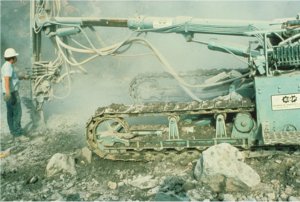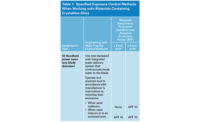
|
| Silica exposure due to an unsafe work practice. Photo by NIOSH/John Rekus. |
Reactions to OSHA’s proposed rule to protect workers from exposure to crystalline silica have come swiftly from the EHS community, along with the industry and business sectors.
OSHA estimates that about 2.2 million workers in the U.S. are exposed to silica dust – nearly 1.85 million of whom are in the construction industry. Airborne exposure to silica occurs in operations involving cutting, sawing, drilling and crushing of concrete, brick, block and other stone products and in operations using sand products, such as in glass manufacturing, foundries and sand blasting.
Crystalline silica causes pulmonary diseases including lung cancer and silicosis in addition to kidney disease.
What would change
The proposed rulemaking would reduce the amount of silica exposure allowed in general industry and the maritime industry by 50 percent. The exposure limit in the construction industry would be cut by 80 percent.
AIHA: "Two years of waiting"
American Industrial Hygiene Association® (AIHA) President Barbara J. Dawson, CIH, CSP issued a statement expressing approval of OSHA’s action, but made a pointed reference to the fact that it came “after more than two years of waiting for the White House to release the proposed rule.”
"The document proposes a new permissible exposure limit of 50 micrograms of respirable crystalline silica per cubic meter of air (50 µg/m3), calculated as an 8-hour time-weighted average,” said Dawson, who said the AIHA will offer more definitive comments as soon as the proposed rule has been thoroughly reviewed.
ASSE: An "opportunity to share best practices"
Kathy A. Seabrook CSP, CMIOSH, EurOSHM, president of the American Society of Safety Engineers (ASSE), said that by finally moving this rulemaking forward, OSHA has given the entire occupational safety and health community the opportunity to share best practices on how to protect workers from a risk that, despite advances in protecting workers from silica risks, still kills more than 150 workers and harms the health of thousands more every year.
“Our hope is that this debate and the information shared can help encourage more employers to provide better protections to their workers as this rulemaking proceeds,” said Seabrook.
Asphalt industry: We're ready
The National Asphalt Pavement Association (NAPA) said that although the proposed level is more stringent than the agency’s current regulations, the work of the Silica/Milling Machine Partnership has positioned the asphalt industry to meet the new standard.
Over the past decade, the partnership — which is made up of NAPA, milling-machine manufacturers, labor, academia, and NIOSH — has worked to identify simple retrofits for existing milling machines that effectively reduce potential silica exposure below OSHA’s new proposed PEL.
While NAPA says the proposed PEL is “achievable,” it intends to file comments offering suggestions to help better calibrate the rule to the industry’s exposure potential.
Additionally, a best practices document for roadway milling based on the work of the Silica/Milling Machine Partnership is expected to be released by NIOSH in the coming months.
“This document will provide a simple roadmap to ensure that any dust generated during milling operations is well-controlled and that workers experience a safe workplace,” according to NAPA.
Some states moved ahead on their own
Tom O’Connor of the National Council for Occupational Safety and Health blamed industry opposition for the delay in releasing the proposal.
“When this rule goes into effect, hundreds of thousands of workers will benefit from increased protections from entirely preventable silica-related disease,” said O’Connor. He pointed out while the federal rule was stuck in “bureaucratic limbo” at the White House Office of Management and Budgets, states like New Jersey and California have passed their own measures, like banning the dry cutting of masonry materials.
“Now, it’s time for all of America’s workers to receive the same protection,” said O’Connor. “The Obama administration should finalize the rule as quickly as possible.”
U.S. Chamber: Changes could harm fracking industry
Mark Freedman of the U.S. Chamber of Commerce said many businesses believe that enforcing the current standard – which was adopted 40 years ago – is sufficient to protect workers. He also expressed concerns that tightening up silica exposure limits would negatively affect the booming fracking industry.
Besides the new exposure limits, the proposed rule details widely used methods for controlling worker exposure and requires companies to conduct medical surveillance, and train workers about silica-related hazards and recordkeeping measures.



